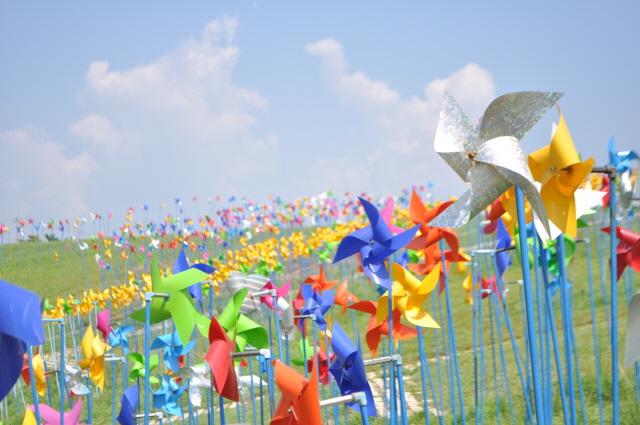Imjingak: Pyeonghoa-Nuri Park
UPON THE green hills under the sheer blue sky shimmer thousands of spinning pinwheels that awaken to the softest breeze a morning could offer. As a giant whale of summer wind playfully roams around the grass, a sweet-scented music twirling and dancing in the air makes everything more beautiful, more immortal—undisturbed by the inundating busyness, this space that cradles peace quietly breathes a life of its own. Yet, not everyone realizes that clipped behind all these quiet details are humble hearts, bleeding and trembling for hope and reconciliation.

From a tragedy it springs
It is like a prayer answered, this place. Established in 2005 through the initiative of the World Peace Festival, Pyeonghoa-Nuri Park is significant because not only does it preserve and promote the universal pacifistic view, but it also laments the tragic reality of the two divided Koreas. Here, Democratic People's Republic Korea (DPRK) does not remain merely as a place that exists in distant memories or overheard rumors; it is just over the *Tong-il* Tower (Unification Observatory). Imjingak area, in which this park is located, has been closely associated with the deplorable history of the Cold War and the ensuing political conflicts that eventually conceived and begot the national division of Korea. Accordingly, this fact parallels the philanthropic, peace-promoting motives with which the *Pyeonghoa-Nuri* Park was installed. Encompassing approximately 24.3 acres of open field that embraces an outdoor theater, 3,000 pinwheels, and other various memorabilia, the park itself serves as a memento of harmony and love that survived through historical tumults.
A papery rainbow of peace
Brimming sunlight twinkles in the far horizon, shining on the faces of thousands of pinwheels whose colors simmer gently to create a forest of rainbows that hovers just above the ground. Most prominent among the artworks scattered throughout the park, the “Hill of Winds,” was devised in 2005 by a writer named Kim Yeon-kyung in hopes of expressing the freedom with which oceans of winds stroll across the Korean peninsula. Without any frontier to impede upon, such movement of winds almost seems to render sovereignty to themselves as they playfully blow kisses to the pinwheels that blithely spin. It makes viewers wistful and even more wishful in contemplating the irony between the light, unrestrained flow of the wind and the chain-bound, grim reality of national division. The discrepancy between the magnificent sight of a rainbow forest and a piece of longing clipped onto each wing of colors is so striking, as the possible future of Korean peninsula's unification and the gap of time that lies between now and then remains inconceivable.
Unveiled entertainments
Along with the artistic inspirations, *Pyeonghoa-Nuri* Park also features a variety of educational programs that provide a comprehensive, unique view on the Korean Demilitarized Zone (DMZ), including those that conduct in-depth investigations on the environmental, historical, and cultural aspects of the region. On the ecological level, participants are accompanied by DMZ eco-tour guides in exploring the region's natural niche while empathizing with Korea’s tragic history that surface on a more personal, tangible dimension as they cautiously yet faithfully follow the wakes of pain and sorrow left behind. Furthermore, they get an opportunity to learn about the *Jangdan* Soybean, a specialty product of the surrounding region, *Paju*, and make soybean chocolates.
In addition to didactical purposes, some of these programs also provide a composite experience of DMZ. Officially known as the DMZ VIP Program, the "VIP" meaning "Volun-tourism in park," this program has been approved by the Korean Ministry of Culture, Sports, and Tourism in providing philanthropic incentives to a large number of visitors. The volunteer activities, which are acknowledged through official certificates, involve taking care of the natural habitats, especially those of indigenous plant species, of DMZ as well as maintaining the surrounding environment under consistent conditions. Furthermore, the park holds diverse cultural events such as musicals, concerts, and exhibitions. For instance, with its large, open field, it featured B-boy performances, the children version of the musical 'Cats,' and movie screening of 'Taming a Dragon.' In a larger and more significant context though, *Pyeonghoa-Nuri* Park is most widely recognized for weaving a sad but hopeful beauty out of Korea’s painful past. It attests and educates individuals about a history that remains to be resolved through various storytelling themes.
* * *
As it goes, a heartless story is told with much heart in this place. This is where an ocean of winds lives in a placid atmosphere, and in them are the sincere hopes of reconciliation dearly cherished in the hearts of millions of Koreans. This is where individuals visit to feel the physical vicinity of North Korea and experience the emotional distance between us and the other group of us over the fence. Simultaneously, this is also where the struggle against that reality is most vibrant in a quiet way. In the end, this is where the hope grows.

